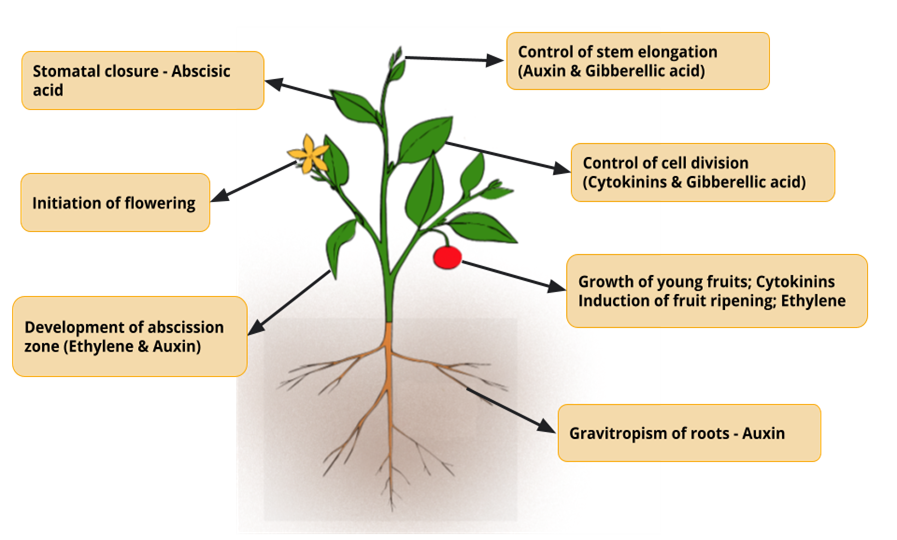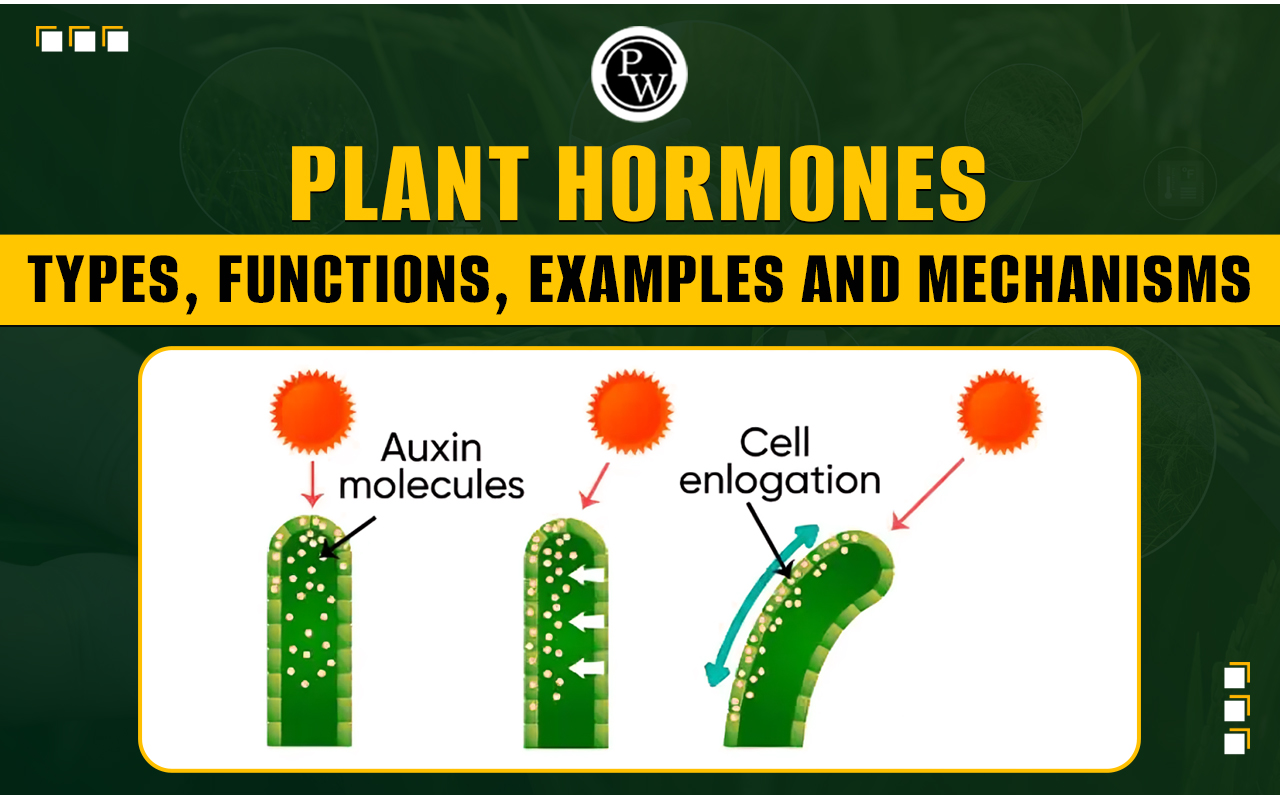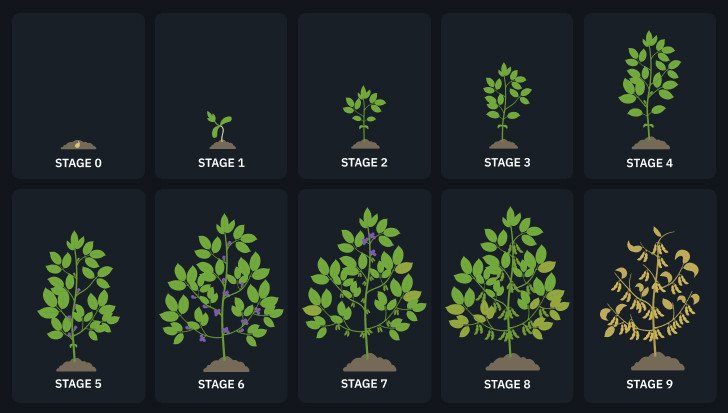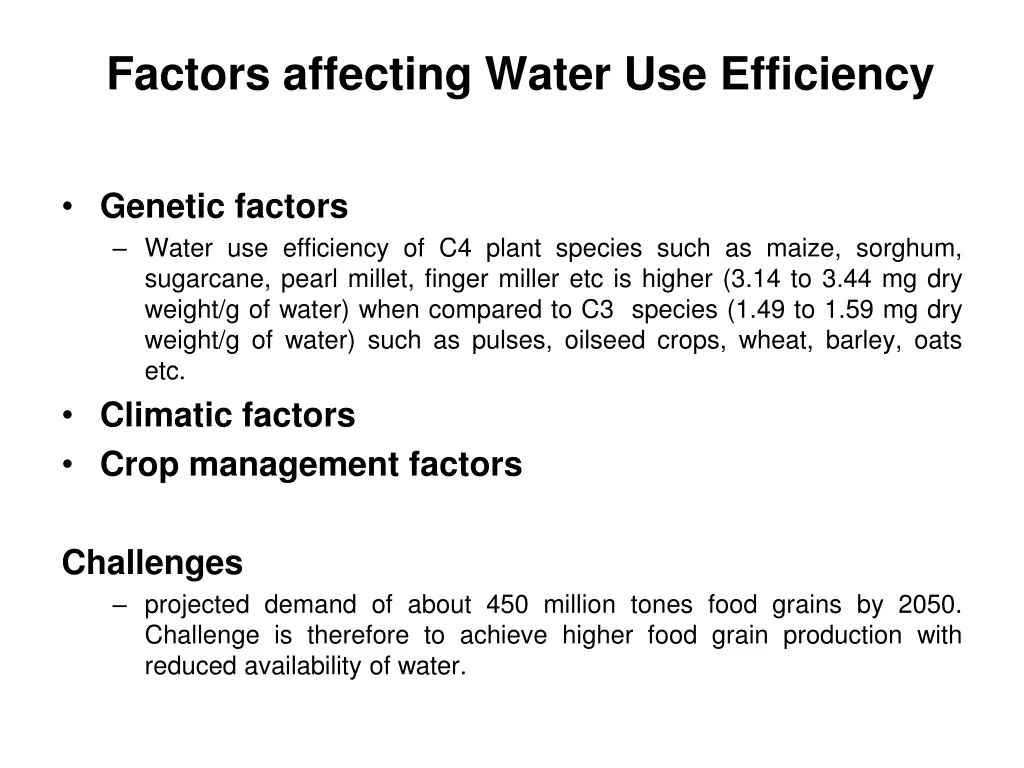
Introduction: The Silent Orchestrators of Plant Life
Plants, those seemingly passive fixtures of our world, are in reality incredibly dynamic organisms. They’re constantly responding to their environment, growing, adapting, and reproducing. But how do they do it? The answer lies in a sophisticated internal communication system, a world of chemical messengers known as plant hormones, or phytohormones. These remarkable compounds, produced in minute quantities, exert profound effects on virtually every aspect of a plant’s life, from the germination of a seed to the ripening of a fruit. Understanding plant hormone functions is key to unlocking the secrets of plant biology, agriculture, and even our own survival.
What are Plant Hormones? Tiny Molecules, Mighty Effects
Plant hormones are organic molecules that act as chemical signals, coordinating various developmental processes and responses to environmental stimuli. They are synthesized in specific locations within the plant and then transported to other parts of the plant where they elicit their effects. Unlike animal hormones, which are produced by specialized glands, plant hormones can be synthesized in almost any plant cell. They act at very low concentrations, and their effects are often amplified through complex signaling pathways.
Think of them as the plant’s internal communication network. Just like a well-coordinated team, plants rely on these hormones to ensure everything runs smoothly. They are the key to growth, development, and response to the environment.
Major Classes of Plant Hormones and Their Functions
Several classes of plant hormones have been identified, each with its unique set of functions. Here’s a closer look at some of the most important ones:
1. Auxins: The Architects of Growth
Auxins are arguably the most well-studied group of plant hormones. The primary auxin is indole-3-acetic acid (IAA). Auxins are primarily produced in the shoot apical meristem (the growing tip of the plant) and young leaves, and they play a crucial role in a wide range of developmental processes:
- Cell Elongation: Auxins stimulate cell elongation, which is essential for stem growth and overall plant size. They do this by influencing cell wall plasticity, allowing cells to expand.
- Apical Dominance: Auxins suppress the growth of lateral buds, a phenomenon known as apical dominance. This results in the plant’s main stem growing upwards, while lateral branches are inhibited. When the main stem is removed (e.g., by pruning), the lateral buds are released from auxin’s control, leading to bushier growth.
- Root Formation: Auxins promote root development, both primary and lateral roots. They are often used commercially to encourage root growth in cuttings.
- Vascular Differentiation: Auxins are involved in the differentiation of vascular tissues (xylem and phloem), which transport water and nutrients throughout the plant.
- Fruit Development: Auxins play a role in fruit development, particularly in the early stages. They can even stimulate fruit formation without pollination (parthenocarpy), leading to seedless fruits.
In essence, auxins are the architects of plant structure, shaping the plant’s overall form and growth patterns. Without auxins, plants would be drastically different, and likely, far less successful.
2. Cytokinins: The Promoters of Cell Division and Beyond
Cytokinins are another major class of plant hormones, named for their ability to promote cytokinesis (cell division). They are primarily synthesized in the roots and transported to other parts of the plant. Their functions include:
- Cell Division and Growth: Cytokinins stimulate cell division and growth, especially in shoots and leaves. They work in concert with auxins to regulate cell differentiation.
- Delaying Senescence: Cytokinins delay senescence (aging) in plant tissues. They slow down the breakdown of chlorophyll, keeping leaves green for longer. This is why cytokinins are sometimes used to preserve cut flowers.
- Shoot Formation: Cytokinins promote shoot formation from calluses (undifferentiated plant tissue) in tissue culture. They are crucial for plant regeneration.
- Nutrient Mobilization: Cytokinins can mobilize nutrients from other parts of the plant to actively growing areas.
- Apical Dominance: Cytokinins counteract the effects of auxins on apical dominance. They promote the growth of lateral buds, leading to a bushier plant.
Cytokinins are the youthful energy of the plant, promoting growth and delaying the inevitable march of time. They are the reason plants stay vibrant and thriving.
3. Gibberellins (GAs): The Growth Boosters
Gibberellins (GAs) are a large family of plant hormones, with over 136 different GAs identified. They are synthesized in various parts of the plant, including young leaves, roots, and developing seeds. Their functions are diverse and include:
- Stem Elongation: GAs stimulate stem elongation, contributing to overall plant height. They do this by promoting cell division and cell elongation in the stem.
- Seed Germination: GAs play a crucial role in seed germination. They stimulate the production of enzymes that break down stored food reserves in the seed, providing energy for the growing embryo.
- Fruit Development: GAs promote fruit development, particularly in fruit enlargement. They are often used commercially to increase the size of fruits.
- Flowering: GAs can promote flowering in some plant species.
Gibberellins are the growth accelerators, pushing plants to reach their full potential. They are essential for the plant to reach maturity and reproduce.
4. Abscisic Acid (ABA): The Stress Responder
Abscisic acid (ABA) is a plant hormone that plays a crucial role in plant responses to stress, such as drought, salinity, and cold. It is synthesized in various parts of the plant, including leaves and roots. Its functions include:
- Stomatal Closure: ABA causes stomata (pores on the leaf surface) to close, reducing water loss through transpiration. This is a critical response to drought conditions.
- Seed Dormancy: ABA promotes seed dormancy, preventing premature germination under unfavorable conditions.
- Stress Responses: ABA activates various stress response pathways, helping the plant to cope with environmental challenges.
- Leaf Senescence: ABA can promote leaf senescence (aging) in response to stress.
ABA is the plant’s stress guardian, helping it to survive in challenging environments. It’s the plant’s built-in survival mechanism.
5. Ethylene: The Ripening Agent and More
Ethylene is a gaseous plant hormone that plays a role in various developmental processes, including fruit ripening, leaf abscission (shedding), and senescence. It is synthesized in various parts of the plant, including ripening fruits, senescing leaves, and stressed tissues. Its functions include:
- Fruit Ripening: Ethylene stimulates fruit ripening, causing fruits to soften, change color, and become sweeter. This is a crucial process for seed dispersal.
- Leaf Abscission: Ethylene promotes leaf abscission (shedding), which is a process of shedding leaves in preparation for winter or in response to stress.
- Senescence: Ethylene accelerates senescence (aging) in plant tissues.
- Stress Responses: Ethylene is produced in response to various stresses, such as flooding and wounding.
Ethylene is the plant’s signaler of change, orchestrating the final stages of fruit development and the shedding of old leaves. It is the hormone of transformation.
Beyond the Basics: Other Important Plant Hormones
While auxins, cytokinins, gibberellins, ABA, and ethylene are the major players, other plant hormones also contribute to plant development and responses:
- Brassinosteroids: These steroid hormones promote cell elongation, cell division, and vascular differentiation. They also play a role in stress responses.
- Jasmonates: These hormones are involved in plant defense against herbivores and pathogens. They also play a role in development and senescence.
- Salicylic Acid: This hormone plays a critical role in plant defense against pathogens, particularly in systemic acquired resistance (SAR).
- Strigolactones: These hormones are involved in shoot branching, root development, and the interaction with mycorrhizal fungi. They also play a role in seed germination.
These additional hormones highlight the complexity of plant communication and regulation.
The Interplay of Hormones: A Symphony of Signals
Plant hormones rarely act in isolation. Instead, they interact with each other in complex ways, creating a symphony of signals that regulate plant development and responses. The balance of hormone levels and the sensitivity of plant tissues to these hormones determine the ultimate outcome. For example:
- Auxin and Cytokinin: The ratio of auxin to cytokinin influences cell differentiation. A high auxin-to-cytokinin ratio favors root formation, while a high cytokinin-to-auxin ratio favors shoot formation.
- Gibberellins and ABA: Gibberellins promote seed germination, while ABA promotes seed dormancy. These hormones work in opposition to regulate the timing of germination.
- Ethylene and Auxin: Ethylene can interact with auxin to influence various processes, such as fruit ripening and leaf abscission.
Understanding these interactions is crucial for fully comprehending plant development and responses. It’s not just about the individual hormones; it’s about how they work together.
Hormones and Environmental Interactions: Adapting to the World
Plant hormones also play a critical role in mediating plant responses to environmental stimuli. Plants constantly monitor their surroundings and adjust their growth and development accordingly. This is where hormones come into play:
- Light: Light influences plant growth and development through the action of auxins and other hormones. For example, plants grow towards light (phototropism) due to the differential distribution of auxins in the stem.
- Temperature: Temperature affects hormone levels and sensitivity. For example, cold temperatures can induce dormancy in some plants, mediated by ABA.
- Water Availability: Water stress triggers the production of ABA, which helps the plant conserve water by closing stomata.
- Nutrient Availability: Nutrient deficiencies can affect hormone levels and plant growth. For example, nitrogen deficiency can reduce cytokinin production.
- Herbivore and Pathogen Attacks: Plants produce hormones like jasmonates and salicylic acid in response to herbivore and pathogen attacks, triggering defense mechanisms.
Plants are incredibly adaptable organisms, and hormones are the key to their ability to thrive in diverse environments.
Applications of Plant Hormone Knowledge: Benefits for Agriculture and Beyond
The understanding of plant hormone functions has numerous applications in agriculture and other fields:
- Crop Improvement: Plant hormones are used to enhance crop yields, improve fruit quality, and control plant growth. For example, auxins are used to promote root formation in cuttings, gibberellins are used to increase fruit size, and ethylene is used to ripen fruits.
- Weed Control: Synthetic auxins are used as herbicides to kill weeds. These herbicides disrupt the normal auxin signaling pathways in weeds, leading to uncontrolled growth and death.
- Plant Tissue Culture: Plant hormones are essential for plant tissue culture, a technique used to propagate plants from small pieces of tissue. Auxins and cytokinins are used to control cell differentiation and growth in tissue culture.
- Biotechnology: Plant hormones are used in genetic engineering to modify plant growth and development.
- Understanding Plant Responses to Climate Change: Research on plant hormones is crucial for understanding how plants will respond to climate change, including drought, heat stress, and changing CO2 levels.
The practical applications of plant hormone knowledge are vast and continue to expand, leading to more efficient and sustainable agricultural practices.
Conclusion: The Future of Plant Hormone Research
Plant hormones are the silent architects of the plant world, orchestrating growth, development, and responses to the environment. Their intricate interactions and complex signaling pathways are a testament to the remarkable adaptability and resilience of plants. Continuing research into plant hormone functions promises to unlock even more secrets of plant biology, leading to advancements in agriculture, biotechnology, and our understanding of the natural world.
The future of plant hormone research is bright. As we continue to unravel the complexities of these essential molecules, we can look forward to new discoveries that will benefit both agriculture and the environment. The more we understand about how plants work, the better equipped we will be to feed the world and protect our planet.


